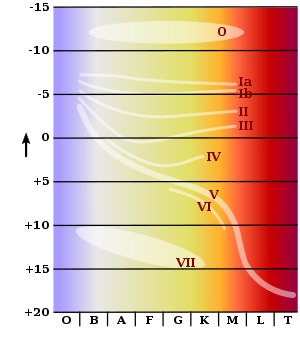Sub giant
A sub-giant is a star whose absolute brightness with luminosity class IV is higher than that of a dwarf star of the same spectral type (luminosity class V), but lower than that of a giant star (luminosity class III). In the Hertzsprung-Russell diagram , the subgiants lie above the main sequence on which the dwarf stars are located.
For some stars, this luminosity class is an intermediate stage in their development from a main sequence or dwarf star to a giant star.
development
Mostly these are stars that have already completed or are just finishing their fusion of hydrogen to helium inside the star . In stars of a mass similar to that of the Sun, this causes the core to contract, causing temperatures to rise here.
The rise in temperature means that the fusion of hydrogen to helium now takes place in a shell that surrounds the core ( shell burning ). The star swells into a subgiant, its diameter and luminosity increase. During this phase, the star continues to cool and its color changes accordingly. An example of a star in this phase is Procyon A .
Further developed subgiants, in a development phase towards giant stars, have larger diameters and lower temperatures than stars of comparable mass in the main sequence (main sequence stars, dwarf stars). The overall brightness changes little during the subgiant stage, a clear characteristic in the Hertzsprung-Russell diagram of globular clusters .
Examples
| Surname | Dimensions | radius | Luminosity |
|---|---|---|---|
| Acrux | 14 M ☉ | 8.9 R ☉ | 4.060 L ☉ |
| Miaplacidus | 3 M ☉ | 5.7 R ☉ | 210 L ☉ |
| Pollux | 2.8 M ☉ | 8.3 R ☉ | 31.95 L ☉ |
| 46 Leonis Minoris | 1.5 M ☉ | 8.2 R ☉ | 32 L ☉ |
| Prokyon A | 1.5 M ☉ | 1.86 R ☉ | 7.73 L ☉ |
See also
literature
- Jeffrey Bennett, Megan Donahue et al .: Astronomy. The cosmic perspective (Ed. Harald Lesch ). 5th updated edition. Pearson Studium, Munich 2010, ISBN 978-3-8273-7360-1 , Chapter 17/18 Red Giants and Development of Low-Mass Stars .
- AG Massevitch : Structure and evolution of the intergiant . In: Commmunications of the Konkoly Observatory Hungary . tape 42 , January 1957, p. 45 , bibcode : 1957CoKon..42 ... 45M (first detailed study in the HRD).
Individual evidence
- ↑ Albrecht Unsöld, Bodo Baschek: The new cosmos: Introduction to astronomy and astrophysics . 7th edition. Springer Spectrum, 2002, ISBN 3-662-45992-2 , p. 188 .
- ^ Hans-Ulrich Keller: Astrowissen: Numbers, data, facts; the ideal companion book for the Himmelsjahr . Kosmos, 2003, ISBN 3-440-09713-7 , pp. 164 .
- ↑ Bastian Henne: Spectral classes and luminosity classes. In: LP. University of Göttingen, October 14, 2011, accessed on January 4, 2020 .
